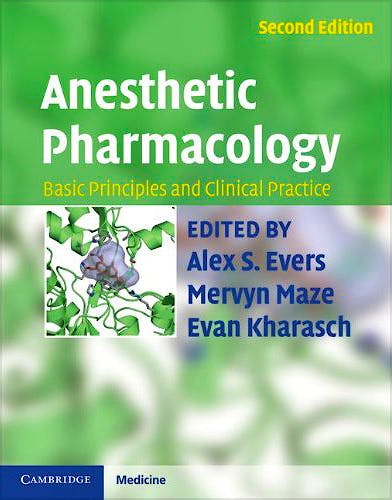

No hay productos en el carrito



Anesthetic Pharmacology. Basic Principles and Clinical Practice
Evers, A. — Maze, M. — Kharasch, E.
2ª Edición Marzo 2011
Inglés
Tapa dura
1196 pags
4700 gr
22 x 28 x 6 cm
ISBN 9780521896665
Editorial CAMBRIDGE
LIBRO IMPRESO
-5%
269,60 €256,12 €IVA incluido
259,23 €246,27 €IVA no incluido
Recíbelo en un plazo de
2 - 3 semanas
LIBRO ELECTRÓNICO
-5%
170,56 €162,03 €IVA incluido
164,00 €155,80 €IVA no incluido
Acceso On Line
Inmediato
Description
In recent years our understanding of molecular mechanisms of drug action and interindividual variability in drug response has grown enormously. Meanwhile, the practice of anesthesiology has expanded to the preoperative environment and numerous locations outside the OR. Anesthetic Pharmacology: Basic Principles and Clinical Practice, second edition, is an outstanding therapeutic resource in anesthesia and critical care: Section 1 introduces the principles of drug action, Section 2 presents the molecular, cellular and integrated physiology of the target organ/functional system and Section 3 reviews the pharmacology and toxicology of anesthetic drugs. The new Section 4, Therapeutics of Clinical Practice, provides integrated and comparative pharmacology and the practical application of drugs in daily clinical practice. Edited by three highly acclaimed academic anesthetic pharmacologists, with contributions from an international team of experts, and illustrated in full colour, this is a sophisticated, user-friendly resource for all practitioners providing care in the perioperative period.
Features
• Exhaustive: covers all the key pharmacologic and physiologic information
on how each drug works at a molecular, cellular and organ level
• Practical: gives all the important drug information an anesthetist needs
– dose ranges, interactions with other drugs, toxicity, use in different
patient groups
• Relevant: the new section on Therapeutics of Clinical Practice tells
the anesthetist how to select and use the right drugs in a wide range of day-to-day
clinical scenarios
Table of Contents
Preface to the first edition
Preface to the second edition
Part I. Principles of Drug Action:
1. Pharmacodynamic principles of drug action
2. G protein coupled receptors
3. Other signalling pathways
4. Signal transduction mechanisms: ion channels
5. Principles of pharmacokinetics
6. Principles of drug transformation
7. Drug transport and transporters
8. Target controlled infusions and closed loop administration
9. Alternate routes of drug administration
10. Principles of pharmacogenetics
11. Pharmacodynamic drug interactions in anesthetic practice
12. Pharmacoeconomics
Part II. Physiologic Substrates of Drug Action:
13. Sleep and consciousness
14. Synaptic transmission
15. Memory, learning and cognition
16. Mechanisms of pain transmission and transduction
17. Generation and propagation of action potentials
18. Neuromuscular junction
19. Vascular reactivity
20. Cardiac rhythm
21. Myocardial performance
22. Autonomic function
23. Physiology of immunity and inflammation
Part III. Essential Drugs in Anesthetic Practice:
24. Mechanisms of anesthetic action
25. Pharmacokinetics of inhaled anesthetics
26. Clinical pharmacology of inhaled anesthetics
27. Pharmacokinetics of intravenous anesthetics
28. Clinical pharmacology of intravenous anesthetics
29. Benzodiazepines
30. a-2 Agonists and other sedatives and amnestics
31. Mechanisms of action of opioids
32. Pharmacokinetics of opioids
33. Clinical pharmacology of opioids
34. Nonsteroidal anti-inflammatory drugs
35. Other ion channel and receptor ligands for analgesia
36. Local anesthetics
37. Anticonvulsant and antipsychotic drugs
38. Neuromuscular blocking agents
39. Reversal drugs
40. Sympathomimetics and vasoconstrictors
41. Parasympathomimetic and parasympatholytic drugs
42. ß-blockers and other adrenergic receptor antagonists
43. Antiarrhythmic agents
44. Positive inotropic drugs
45. Vasodilators (incl. ACE inhibitors and NO)
46. Calcium channel blockers
47. Bronchodilators
48. Pulmonary vasodilators
49. Drugs acting via the kidney
50. Fluids and electrolytes as pharmacologic agents
51. Corticosteroids and anti-inflammatory agents
52. Anti-rejection drugs and immunosuppressants
53. Antimotility and antisecretory agents
54. Antiemetics
55. Insulin and anti-hyperglycemic agents
56. Nutritional elements of management
57. Agents affecting coagulation and platelet function
58. Obstetrical adjuvants and obstetric pharmacology
59. Antimicrobial therapy
Part IV. Clinical Application and Anesthesia Practice (Evidence Based, Rational
Drug Selection, Management): 60. Pre-operative management
61. Induction of anesthesia
62. Maintenance and emergence from anesthesia
63. Management of sedation, analgesia and delirium
64. Post-operative analgesia
65. Control of blood pressure and vascular tone
66. Cardiac protection and pharmacologic management of myocardial ischemia
67. Management of patients with chronic alcohol or drug use
68. Drug allergy and treatment
69. Special populations – pediatric
70. Special populations – geriatric
71. Emerging concepts: neuroprotection and neurotoxicity
Index.
© 2025 Axón Librería S.L.
2.149.0